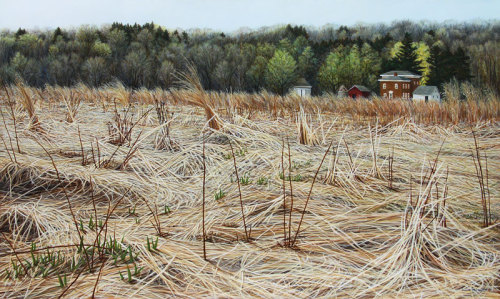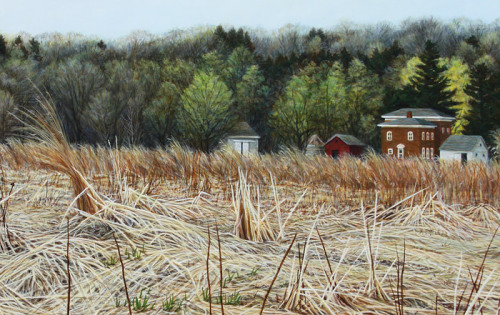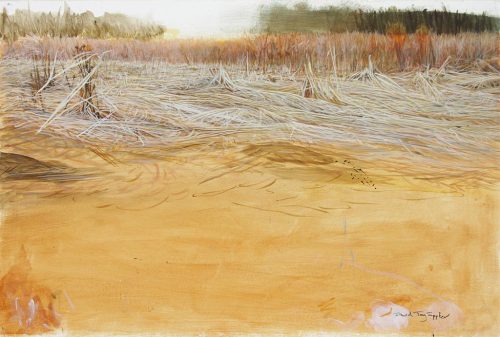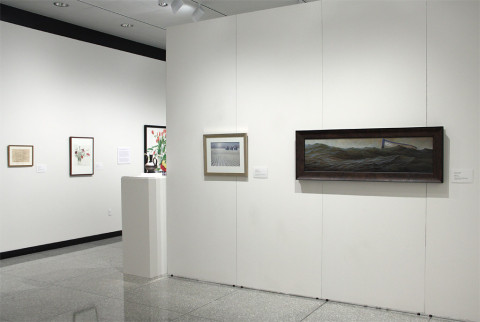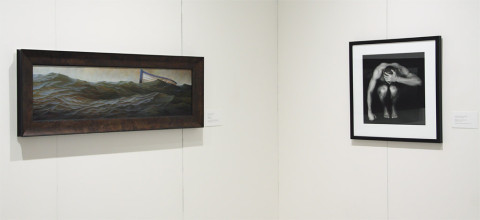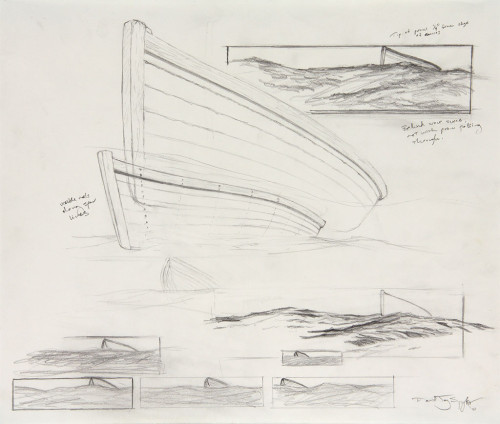Artist's Statements Artistic Motivations Exhibitions: Artist's Statement Exhibition Kalamazoo Institute of Arts Painting Philip Jamison Spring Winter
by David Jay Spyker
leave a comment
“Double Take: Artists Respond to the Collection” at the KIA
When asked if I’d like to be part of Double Take at the Kalamazoo Institute of Arts, I was more than happy to participate. A show in which I get to pick a piece from the collection and create my own work in response, and then the two would hang side-by-side? Of course I wanted to do it!
Subsequently browsing the collection on the Institute’s website, then visiting the vault to see my possible selections in person was a treat. There is some really great art in the KIA’s collection. In the end, I chose a watercolor by Philip Jamison titled “Milkweed” as my companion piece.
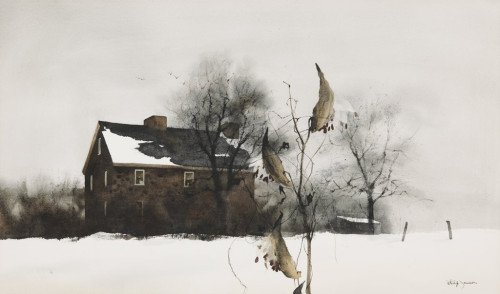
Philip Jamison, American, b. 1925
Milkweed, ca. 1950-1960
Watercolor on Paper
Collection of the Kalamazoo Institute of Arts; Gift of Mr. and Mrs. Donald S. Gilmore
Copyright Philip Jamison, image used by permission of the artist
The quiet atmosphere and solitude in Milkweed immediately made me think of a special place just a few miles from home, though I planned to paint my scene in a different season that was more personal to me.
As part of the exhibition, we were asked to write a short text speaking to the relationship of our work to our chosen piece, which would display with the paired art.
To me, Milkweed has a certain sense of quiet isolation, a solitude, which I am often looking for in my own work. When I manage to catch that mood in a scene, I feel like I’ve done something special with the painting. I can only imagine Philip Jamison must have the same sense of satisfaction when he captures a deep feeling in one of his own works.
There is a prairie tallgrass field north of Kalamazoo, and in early Spring, gentle breezes tickle last year’s dead stalks to create a quiet, pervasive whisper. If you stand for a while – with nothing but that dry rustling and the occasional bird song all around – and feel the changing vernal light and the zephyrs on your skin, you begin to get a sense of magic; it’s as if the whole world is whispering something unknown, yet deeply important.
I wrote to Mr. Jamison to tell him about the exhibition, and to ask if it would be alright to use the image of his painting for this article. What a thrill it was to read Philip’s letter in response! At 89 years of age he writes that he has been “unusually busy” lately. I hope to one day reach that age and still be busy making art.
He also writes “I have used milkweeds in many of my paintings simply because they are so prevalent in my part of Chester County…. I have vases of them in my studio…. and they have been there for over forty years”. That got me thinking of when I was a kid wandering the woods and empty fields near my house in Rochester, New York, and how each year the milkweed pods were such a source of fascination.
It was irresistible to pluck them and pry them open; I’d get the sticky milk all over my fingers, and explore how the seeds were packed inside with their silky threaded parachutes. Later in the year, when the pods would eventually split open on their own, I just had to blow handfuls of those seeds into the air.
Even today, on walks through fields, it makes me happy to see milkweed plants, and sometimes I still stop to play with the pods.
“Double Take: Artists Respond to the Collection at the KIA” is at the Kalamazoo Institute of Arts from 8/16/2014 – 1/18/2015. The show features the works of thirty area artists displayed with their corresponding selections from the KIA’s permanent collection.
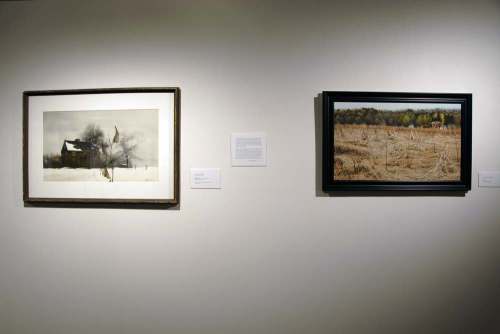
Philip Jamison’s “Milkweed” with David Jay Spyker’s “Whisper”
hanging at the Kalamazoo Institute of Arts
Photo courtesy of the KIA
Kalamazoo Institute of Arts, 314 S. Park St., Kalamazoo, MI 49007
www.kiarts.org
Artistic Motivations Exhibitions: Boats Exhibition Kalamazoo Institute of Arts Preliminary Study Water
by David Jay Spyker
leave a comment
“Cradle” Displayed in “Copley to Kentridge: What’s New in the Collection?”
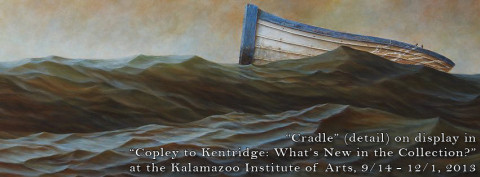 The painting, Cradle, joins more than 100 other recently acquired works in “Copley to Kentridge: What’s New in the Collection?” at the Kalamazoo Institute of Arts.
The painting, Cradle, joins more than 100 other recently acquired works in “Copley to Kentridge: What’s New in the Collection?” at the Kalamazoo Institute of Arts.
Completed in 2011, Cradle entered the permanent collection of the KIA in 2012. It will hang with works by notable artists such as George Tooker, John Singleton Copley, Robert Mapplethorpe, Jackson Pollock, Stephen Hansen and many others.
In 2012, Cradle won 1st place at the Regional Fine Arts Competition at the Carnegie Center for the Arts in Three Rivers, Michigan. It also took the 2nd place award at the Michiana Annual Artist Competition (10th MAAC) at the Box Factory for the Arts in St. Joseph, Michigan the same year.
Whether it’s a river, one of the Great Lakes, the ocean… water, to me, is an expression of spirituality, healing, and the timeless power of nature. It might represent a journey, or reference change over the course of time. It’s the source of life for all living things, and at the same time can engender something primeval and elicit emotions of unease or even danger.
The title of a piece has always been very important to me. When I choose a title, it comes from my own personal understanding of the painting. The meaning may not be immediately apparent on an outward level, but the title should reference my own thoughts and feelings about the image. Very often, the title will point to several different meanings, and when it does I feel I’m really getting something right.
In Cradle, I’ve used the boat as a metaphor for both the individual and humanity as a whole. The old boat also has the shape of a cradle of sorts. It carries us on the water, which here represents all of life. The water becomes a cradle for the boat, and encompasses birth, life, and death.
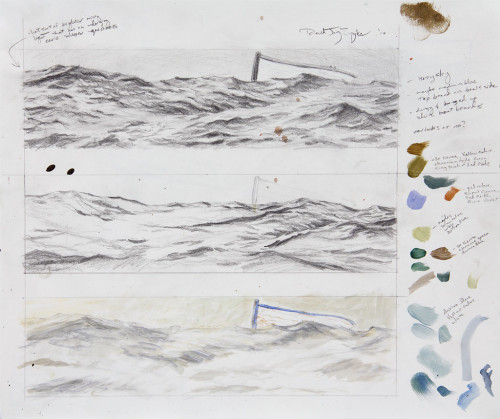
Study for “Cradle”, 2010, graphite, watercolor, and acrylic on paper, 14 x 16.5 in., by David Jay Spyker
When Cradle was at the 2012 competition in St. Joseph, Michigan, a woman who was part of a creative writing group there came up to me and said they each had to choose a piece in the show and write a story based on it. She chose Cradle, and said she imagined there was a man lying in the boat, that he had been there a long time, and whether he was alive or dead was something of a mystery. I felt Cradle conveyed a sense of strange mystery as well, so hearing what she said was encouraging.
Thoughts and especially emotions are something I’m trying to conjure when someone looks at my art, so people’s interpretations of my paintings – learning what kind of thoughts and feelings they have when they engage with it – that’s always interesting.
“Copley to Kentridge: What’s New in the Collection?” is on display 9/14 – 12/1, 2013 at the Kalamazoo Institute of Arts, 314 S. Park St., Kalamazoo, MI 49007.
